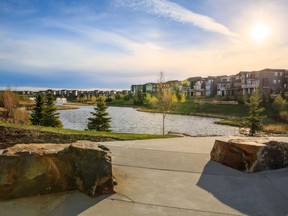Article content
It’s a dry topic, but drought is top of mind for many Albertans. This winter has seen unseasonably warm temperatures and a lack of snowfall, which could mean an even drier summer than that of 2023. According to Agriculture and Agri-Food Canada, pockets of extreme drought are embedded in areas of severe drought throughout southern Alberta and southwestern Saskatchewan, with less intense drought conditions elsewhere on the Prairies.
Article content
Snowmelt in the Rocky Mountains feeds many southern rivers, and while there is still time for more snowfall, the prospect of limited meltwater runoff this spring looms large. Filling reservoirs for irrigation and domestic uses hinges on this supply.
The Alberta government has struck a drought command team and announced the largest-ever water negotiations among users and licence-holders.
However, another piece of the drought-busting puzzle needs more attention — natural infrastructure. Natural infrastructure allows us to work with nature to help meet infrastructure needs.
The stormwater pond in your neighbourhood that you walk by and admire the ducks? That’s a form of natural infrastructure that helps store and treat water and support wildlife. In cities, rain gardens, green roofs and soil cells that keep trees alive help address dry conditions. In rural areas, wetlands and river shorelines help by capturing and slowly releasing water into the environment, and assist in recharging local aquifers.
This week, experts from across Canada gathered in our city to discuss solutions to water infrastructure needs at the Advancing Natural Infrastructure Forum. The focus is on solutions with definite water benefits, and the need to include natural infrastructure in government planning processes. The current drought has already brought discussions of aquifer recharge and water policy into more water-cooler and boardroom conversations. We all need to pay attention.
Article content
“The lack of snow is particularly troublesome for farmers, who need soil moisture and irrigation for their crops, and will affect the reliability of domestic and industrial water supplies,” said Rick Lawford with the Group on Earth Observations, who has worked on drought preparedness on the Prairies for more than 15 years. “Spring and summer drought impacts on biodiversity can include less habitat for fish and waterfowl as wetlands and soils dry out. If the drought continues through the summer, wildfires could be intensified and groundwater reserves will decline.”
Another dry summer could lead to new requests by industries and farmers for more government assistance. Last year, the provincial and federal governments provided $165 million to support livestock producers affected by drought and poor growing conditions.
“To support drought resilience for farmers and communities, we need to enhance natural infrastructure,” said Lawford. “Lessons from the past, and from Australia and California, show that we can work with nature to lessen drought impacts. Regenerative agriculture is gaining attention because of the benefits of no-till and continuous crop cover for soil health. Water retention sites across the Prairies help farmers with both local flooding and water supply. Protecting key landscapes that support water supply is essential for long-term water security.”
Article content
In the face of drought, we need to marshal our most effective engineered and ecological solutions. Pragmatic actions, such as multi-sector drought planning and water conservation, are essential. But we also need to improve our ability to save water on the landscape through smart investments in water recharge and natural storage. Natural reservoirs should be identified, preserved and accounted for in decision making.
In 2022, it is estimated that the Prairies’ natural infrastructure sector directly employed more than 33,000 people and contributed $4.1 billion to the region’s GDP. Strengthening existing programs with clear track records of positive outcomes — such as Alberta’s Watershed Resiliency and Restoration Program, which invests in local watersheds to protect against floods and droughts — is a promising avenue to build on strengths.
Focusing on drought resilience and investing in natural infrastructure can improve watershed health and function as a physical buffer against the impacts of future droughts.
Natural infrastructure won’t solve Alberta’s drought problem overnight, but it’s an important solution for our tool box that provides many benefits and should be invested in for our future.
Josée Méthot is a senior policy specialist, water, with the International Institute of Sustainable Development and part of the Natural Infrastructure for Water Solutions Initiative. She lives in Calgary with her family.
Share this article in your social network



)






